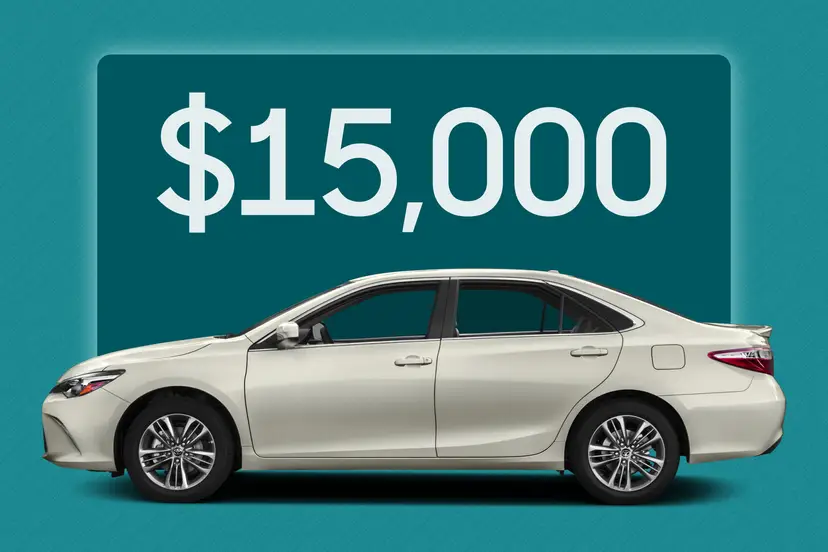
The 2014 Toyota Highlander’s cavalcade of improvements make a formerly bland, middle-of-the-road SUV stand out with bold styling and improved family friendliness.
Toyota listened to consumers while redesigning the seven/eight-seat 2014 Highlander and responded to demands for more cabin and cargo room, dynamic styling and premium amenities. Requests for a more dynamic driving experience should have been respectfully ignored, however, as the 2014’s harsher ride is a tradeoff I don’t think many midsize SUV buyers should have to live with in return for sportier handling.
Still, other improvements will undoubtedly appeal to shoppers who had scratched the previous Toyota Highlander off their list or at least to those who don’t consider a comfy ride a must-have. The 2014 Highlander’s increased cargo room behind the standard third-row seat is a much-needed improvement; plus, it’s easier to get into the third row, which now seats three and bumps standard seating capacity to eight. Compare the 2013 Highlander with the 2014 here.
With upgrades that span the lineup of LE, LE Plus, XLE, Limited and Limited Platinum trim levels, the 2014 Highlander is now in much better shape to take on the 2014 Hyundai Santa Fe, 2014 Ford Explorer and 2014 Honda Pilot (compare the 2014 Highlander with its competition here). I drove four-cylinder, six-cylinder and Hybrid 2014 Highlanders at a Toyota media event.
Exterior & Styling
Toyota went back to the drawing board to redesign its aging and stylistically devoid Highlander. Fast-forward to 2014, and you can’t call the Highlander boring looking any longer. The 2013’s ho-hum appearance transforms into a hulking SUV with a beefier stance, bulging fenders and bold front styling. Its presence was big on the 2013 New York International Auto Show floor where it debuted, and it looks just as good rolling down the street.
How It Drives
The driving experience isn’t the car’s most appealing attribute, even with an assortment of promising new chassis and suspension changes, so it’s good the new SUV does so many other things well.
Toyota picked curvy canyon and coastal roads in California to demonstrate the Toyota Highlander’s new handling chops. Driving a 2013 and 2014 back to back, the 2014 does exhibit higher levels of road grip and an enhanced steering response. It’s more athletic when digging into a corner, though I wouldn’t call the Highlander fun to drive. The 270-horsepower V-6 doesn’t have an immediate punch of acceleration in the heavy Highlander. It’s a far cry from the lighter, 290-hp Hyundai Santa Fe, which is a “little” ball of excitement among other similar three-row SUVs. A six-cylinder Highlander LE with front-wheel drive is 4,244 pounds, while a V-6, front-wheel-drive Santa Fe GLS is 3,933 pounds.
An adverse effect of the Highlander’s newfound dynamics is a choppier ride over rough roads. After driving 2013 and 2014 models, I could tell the 2014 transmits more road imperfections through the chassis and into seats. Hey, Toyota: It’s OK to have an aggressive design and ride like a sofa; see the 2014 Chevrolet Impala.
On the upside, the 2014 Highlander has a more substantial feeling over rough roads, with fewer rattles, squeaks and chassis flex. It’s a matured experience with increased sound insulation, acoustic glass and a stiffer chassis helping keep outside noise minimal.
I briefly spent time in the four-cylinder Toyota Highlander with front-wheel drive, which Toyota expects to account for 5 to 10 percent of sales, and also in the all-new Highlander Hybrid. Both the front-wheel-drive-only four-cylinder (20/25/22 mpg city/highway/combined) and all-wheel-drive-only Hybrid V-6 (27/28/28 mpg) are a little rough around the edges as far as engine noise and vibrations. The Hybrid’s gas mileage is relatively unchanged for 2014, down 1 mpg in city ratings to 27 mpg but maintains its 28 mpg combined rating. The transition from electric to when the engine fires up is noticeable with raw noises coming from under the hood, audible from across a parking lot. Vibrations from the transition are minimal, but the noises are loud enough to take notice.
An extra 353 pounds added to the hybrid from three electric motors — two in the front and one in the back — and a nickel metal hydride battery is noticeable in how the Hybrid drives compared to the Limited V-6 with all-wheel drive. It’s a relaxed experience less excited about accelerating and handling even with 280-hp combined, and it also doesn’t ride any smoother than the non-hybrid.
The Hybrid’s unusually loud engine noises wouldn’t be as much of an issue if the Highlander Hybrid weren’t $48,160 with destination, $7,130 more than 2013 — a 2014 Lexus RX 450h is $47,320, though much smaller on the inside. The Highlander Hybrid’s luxury car price doesn’t reflect luxury refinement now that the feature-loaded Hybrid Limited is the only Hybrid offered; the less-expensive version got the axe for 2014.
The volume-seller V-6 is the most refined of the bunch, offering smooth and predictable acceleration as well as the best handling with all-wheel drive. The V-6-powered Highlander’s gas mileage of 19/25/21 mpg with front-wheel drive and 18/24/20 mpg with all-wheel drive is also more competitive than the outgoing 2013 thanks to a new six-speed automatic transmission replacing a five-speed unit on V-6 models. The all-wheel-drive system, which is also new, helps add 2 mpg highway over the 2013 version. All-wheel-drive Highlanders send torque to the rear wheels when slippage is detected, versus the previous system that always sent torque to four wheels.
Interior
Part of the 2014’s transformation includes dialing up the interior styling with numerous soft-touch and accent-stitched interior panels that enhance the classiness. The quality is Toyota-Avalon nice with a stitched dashboard, steering wheel and soft-touch, high-quality materials in prominent locations. Plastic areas that aren’t textured, stitched or covered are still on par for the class. Even the base LE Highlander exudes the almost luxurylike niceness of the higher-optioned Limited trims.
Seating is comfortable in the first and second rows with soft, wide front seats and a highly adjustable second row that slides and reclines with two captain’s chairs or the standard three-seat bench configuration — captain’s chairs are available on the XLE and standard on the Limited. The rest of the Toyota Highlander may have been redone with dynamism in mind, but the seats speak to its comfort-focused roots. Many people on our staff will miss the 2013’s removable second-row center seat. I won’t, as it was uncomfortable and bulky to remove and replace with the center table that stored under the center console.
In the third row, Toyota increased width and added an extra seat for a maximum capacity of eight occupants in standard configuration. A new, more compact rear suspension freed the additional space. The third row still doesn’t fit adults with as much comfort as the larger Chevrolet Traverse, but it’s good in a pinch. There are also new one-touch folding second-row seats on both sides. Previously, only the curbside seat folded and slid forward via the one-touch lever. Third-row riders also benefit from the second row’s increased seat travel, which allows easy entry and exit.
Ergonomics & Electronics
Technology is a huge focus in the 2014 Toyota Highlander and done very well. Toyota’s Entune multimedia system works better than ever compared with other Toyota vehicles in which I’ve used the system. Working the Entune system’s voice commands is impressive. The models I tested picked up on the various voice commands I spoke.
Those with bulky phones or who constantly have their phone connected to the SUV will appreciate a device storage ledge below the climate controls that provides a pass-through for USB cords. There should be no more Medusa-like dangling of cables entangling the gear selector.
The standard Entune on base LE models includes a 6.1-inch touch-screen with backup camera, USB port with iPod connectivity, auxiliary input, voice recognition, Bluetooth phone connectivity and Bluetooth streaming audio. LE Plus trims have Entune Audio Plus with a higher-resolution 6.1-inch display, HD Radio and 90-day satellite radio subscription. The next step up is Entune Premium Audio with Navigation and App Suite on XLE models with an 8-inch touch-screen and app suite with Pandora, Yelp and Facebook integration with a smartphone and accompanying Entune downloadable application. A JBL sound system is standard on Limited trim levels.
The massive center storage bin between the front seats can devour anything plus-sized, like a purse, iPad or Blu-ray collection for the available rear-seat Blu-ray player. And when you forget that Blu-ray at home, an interesting new feature called Easy Speak transmits the booming voice of an angry mom or dad through the rear stereo speakers via the Bluetooth microphone to keep rowdy kids in check. How much more family focused can you get than providing a feature that allows parents to yell at kids?
Cargo, Towing & Storage
Cargo room behind the third row improves over the previous Toyota Highlander’s skimpy ledge, which struggled carrying groceries, let alone a stroller or golf bag. The cargo volume is now rated at 13.8 cubic feet, up from 10.3 cubic feet. It’s not a huge improvement, but at least it makes the area usable. It’s still small compared with others in the segment: The Explorer has 21 cubic feet and the Pilot has 18 cubic feet behind the third row. Toyota’s trickery to increase cargo room involved moving all three rows of seats forward, adding length behind the rear wheels and using a more compact rear suspension.
The power liftgate is an impressive feature to be standard on LE Plus trim levels and above, and has a trick up its sleeve: It adjusts to various heights, not just one or two predetermined height settings. With the liftgate in motion, users can stop the liftgate and program it to open to that set height the next time. The feature will make shorter drivers and owners of low garages very happy. (If the gate goes too high, shorter folks might struggle to reach the power-close button on its bottom edge.) Another unique feature on the back is an oldie but a goody: On LE Plus models and above, the rear window opens for easy access independent of the cargo gate.
A 5,000-pound tow rating on XLE and Limited trim levels comes with a standard towing package that includes engine/transmission coolers and upgraded radiator and alternator. Hybrids can tow 3,500 pounds, V-6 LE/LE Plus can tow 2,000 pounds and a four-cylinder LE is rated at 1,500 pounds.
Safety
The 2014 Highlander hadn’t been crash-tested at the time of this writing.
The 2014 Highlander provides lower anchors and tethers on outboard second-row seats for child-safety seats, but only a tether anchor on the middle third-row seat.
Advanced safety features are available, though only on the pricey Limited trim level where a blind spot monitoring system and rear parking assist are standard, and pre-collision, adaptive cruise control and lane departure warning are optional. Limited trim levels are also the only models with a backup camera that uses predictive guidelines to show the vehicle’s path — a backup camera with fixed lines is standard on all other trim levels. See more of the Highlander’s safety features here.
Value in Its Class
Toyota says pricing is up about $1,500 on average across the 2014 trim levels, which include additional features over the 2013. Base pricing starts at $30,075 for a base four-cylinder LE with destination, while volume-seller Toyota Highlander XLE models with all-wheel drive are $38,360 and include leather seating with heated front seats, navigation, three-zone climate control, smart keyless entry, second-row sunshades and more. Pricing for the XLE is very competitive to three-row midsize SUVs like the Honda Pilot, Ford Explorer and even the Hyundai Santa Fe.
The 2013 Highlander was truly a midpack three-row SUV, lagging behind in important areas like interior quality, cargo room and technology. Rest assured, if you’re a Highlander owner looking to upgrade — as long as you’re unconcerned about ride quality — the 2014 is not only a compelling upgrade, but also worthy of cross-shopping the segment’s best.


































.png)


